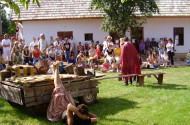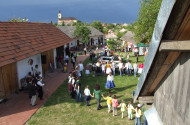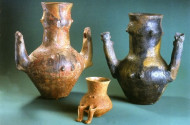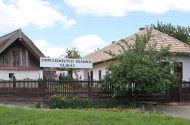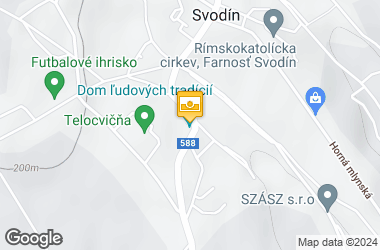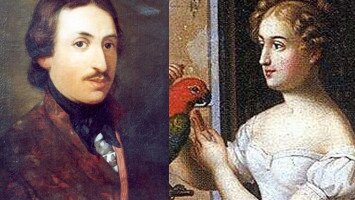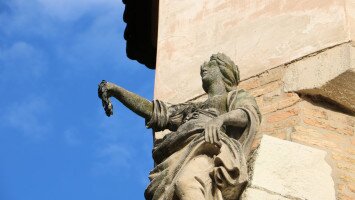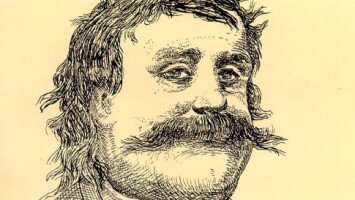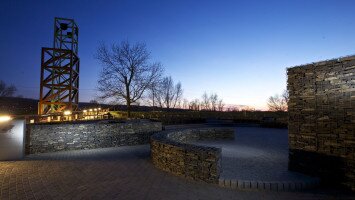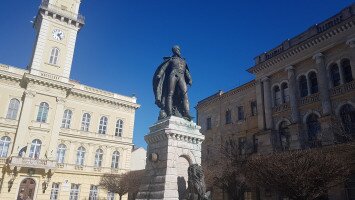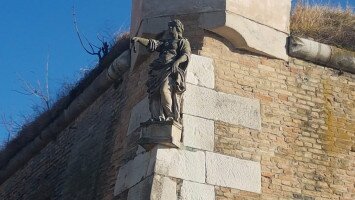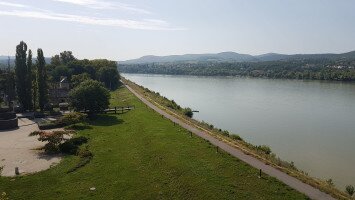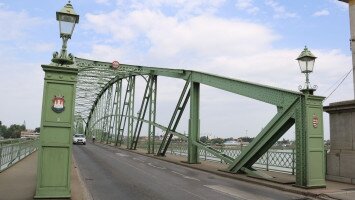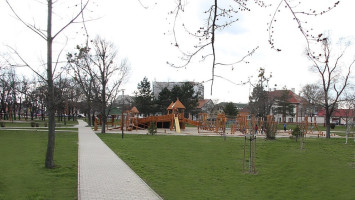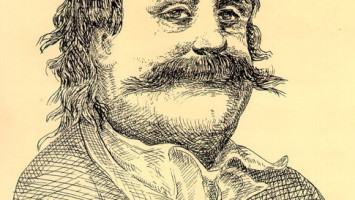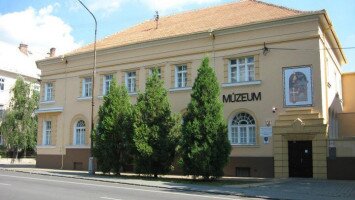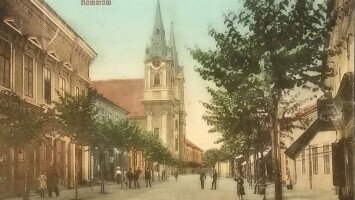
Country house
It was housed in one of the former farmhouses, which, with its huge farmyard and outbuildings, seemed particularly suitable for this purpose. It was opened on October 14, 2005, as a branch of the János Thain Museum in Nové Zámky.
We enter our yard through a slatted "barn", which is part of a typical slatted fence. From here we enter the kitchen, where different dishes are lined up on an open stove. Next to the wall is an alarium, a "sporhelt" in the corner of the room. The equipment is complemented by stellaz and a water bench, there is no lack of the characteristic embroidered wall protector. The window is decorated with a simple curtain sewn from cardboard. In this room, they mainly cooked and maybe did other housework. From the right opens the first room (first house, clean room), with its typical furnishings: two beds under the window, a table and four chairs, a mirror on the wall. In the corner is a cast iron stove, with a tablecloth and a statue of Mary on it. Sacred images on the walls, simple curtains on the windows, home-woven rag rugs on the floor. This room was used by some family members for sleep as well as for ceremonial occasions, but it is also used for weaving in winter. To the left of the kitchen is the back room, where next to the door is a hatched stove, next to it is a wooden chest. In the corner, under the window is a corner bench, in front of it is the table. There is also a bed, next to it a sewing machine, at the end a closet. Another place to lie down is the bunk, a homemade low plank bed with a straw bag and a horse blanket. In addition to the stove, there is also a water bench. On the walls are the indispensable sacred images, the equipment is complemented by simple curtains, bedspreads and wall protectors. This place was a living room in the modern sense - in winter the family is a permanent place of residence (they also cooked here). From here we get to the chamber, which is furnished with a box of flour, glazed pots, flour sacks, a table with a kneading bowl (bread was also kept here).
On the walls mostly hang kitchen utensils - cutting board, cabbage planer, mangrove, kneading board, files. On the side of the house is the extended roof, from which it is possible to enter the living quarters and the barn.
The barn is at the end of the house. The attic driveway was formed at the back wall of the barn, and behind it stood the barn. It is typically a multifunctional building. At the end of the barn is the press house, the cellar entrance led from the courtyard.
The building opposite the house consists of two parts. The summer kitchen is in front, they cooked here from spring to autumn, and the family members stayed here during the day as well. Dirty housework was also done here. At the back, the granary was housed where the grain crop was stored. There is a wheeled well in front of the door of the summer kitchen, and masonry sheds line the granary. A gate opens from the back of the courtyard.
Archeological Museum
It is located next to the country house. Archaeologists of the Slovak National Museum excavated the remains of the destroyed St. Michael 's Church and an even older church on its site between 1995 and 2001. As interesting and instructive findings were found, the municipality decided to present the results of this research to the public in the form of an exhibition. To this end, he bought another building next to the country house. It is a one-storey, rectangular house with a pillared corridor facing the courtyard. It consists of three rooms (front room, kitchen and back room) in which visitors can systematically view the results of archaeological research. From the outside, there is an entrance to the middle room, which also serves as a hall.
In the room opening to the right, you can see the finds from St. Michael's Church. The site of this church was probably a smaller chapel, a place of worship, already during the reign of St. Stephen (1000-1038). It was later rebuilt into a sanctuary to which the nave was added in the 13th century. It was demolished by fleeing Turkish troops in 1685, and a new church was built on its site in 1731. As already mentioned, it was blown up by retreating German soldiers in 1945, and although most of it remained standing, it was not rebuilt. Instead, the ruins were demolished and the material was used to build the bus garage. Archaeological excavations carried out here uncovered 218 graves (32 of them children’s graves) and coins, necklaces, silver needles and buttons, boots, clay pots, etc. from 14-17th centuries were found here. Storage stacks were found in the church garden, where food, drinks, and valuables were kept in them during the Turkish war. A number of coins have also been found around the church, the oldest being from Marcus Aurélius (139-161) and the newer ones from the reign of Maria Theresa (1740-1780). Many necklaces, crosses, weapons, tools, ceramics and glassware have also been unearthed, as well as silver, copper and semi-precious jewelry, the most interesting of which is a pocket watch, which is also a compass.
The finds during the excavation of the Church of the Virgin Mary in the German-American part of the village were exhibited there. Archaeological excavations of this church have shown that it was built in the 11-12. centuries and it was 25 m long. The maximum width of its ship reached 11.5 meters. There are 150 cm wide base trenches from the church and 200 cm wide on the west side. A stone block measuring 205 x 200 cm was excavated in the western part of the nave, which was probably the basis of the bell tower that belonged here to the wooden chapel that stood here in front of the stone church. The church was permanently destroyed during the Turkish wars. Today, in this place stands the statue of the Virgin Mary, which the locals call only the “image of Mary”.
Around the church, 90 graves were unearthed, with many coins in them. One of them (damaged) dates back to the time of the Roman Empire, the rest from the periods between the 13th century and the second half of the 18th century. Necklaces, crosses, Haban knives and keys, as well as gold, silver and copper necklaces with garnet stones were found in three tombs. The most valuable find is a Romanesque bronze crucifix with traces of gilding. The body has a crown on its head and its left shoulder is broken. All of these finds can be seen in their original form or in a photograph, and lifelike copies of valuable jewelry will be made later. Most cities in Slovakia cannot boast of such an exhibition. As for the left-facing room of the museum - which is the so-called there was a back room - where visitors can see documents depicting the life of the Csongrády family and Sister Nicefora from the family Mária Király from Svodín.
Opening Hours:
Tue - Fri: 9.00 – 12.00, 13.00 – 16.00
Sat – Sun: registration required
Contact:
Svodín, č. d. 305, 306
Tel.: +421 0904 021 807, 0915/ 134 658
E-mail: muzeumsvodin@gmail.com
Web: http://muzeumnz.sk
FB. https://www.facebook.com/TajhazSzogyen/
